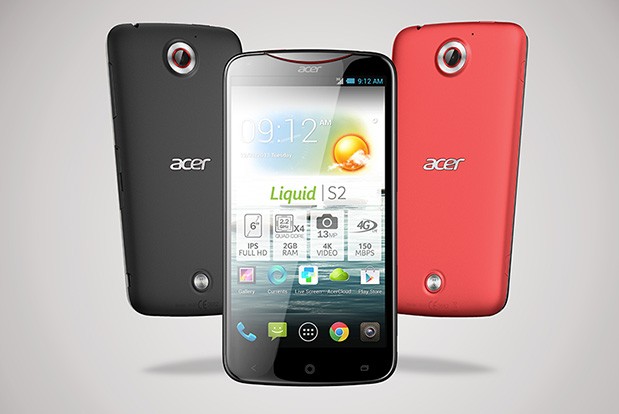Acer Unveils 6-inch Smartphone with 4K Video
Acer's newest Liquid S phone features high-end specs and the ability to shoot video in 4K.
We're living in the age of the super phone. With octa-core CPUs, GBs of RAM, and larger-than-life displays, we've come a long way since the days of the first iPhone and T-Mobile's G1, and companies every day are coming up with ways to make their devices bigger and badder than before. This past weekend, Acer announced the Liquid S2, a 6-inch smartphone capable of shooting 4K video.
Announced at IFA, the device packs a 6-inch full HD IPS display (1920 x 1080, 386 PPI), a quad-core CPU clocked to 2.2 GHz, 2 GB of RAM, a 13-megapixel camera, a 2-megapixel camera in the front, 16 GB of storage, a 3300 mAh battery, WiFi, Bluetooth 4.0, GPS+GLONASS, NFC, and support for the 800/1800/2600 frequencies for 4G and 900/2100 for 3G. The whole show is running on Google's Android 4.2.2 operating system with Acer's Float UI on top. Of course, the stand-out feature is the fact that this device can shoot video in 4K. Right now, there isn't much 4K content out there, something about which anyone with a 4K TV is all too aware.
The Acer Liquid S2 will be available in October, though Acer hasn't discussed pricing and precise dates of availability just yet. We imagine that means there won't be one global roll-out and the phone will instead enjoy a staggered launch across multiple regions. Stay tuned and we'll keep you posted!
Follow Jane McEntegart @JaneMcEntegart. Follow us @tomshardware, on Facebook and on Google+.
Get Tom's Hardware's best news and in-depth reviews, straight to your inbox.

Jane McEntegart is a writer, editor, and marketing communications professional with 17 years of experience in the technology industry. She has written about a wide range of technology topics, including smartphones, tablets, and game consoles. Her articles have been published in Tom's Guide, Tom's Hardware, MobileSyrup, and Edge Up.
-
rocknrollz More like 1080p, then scaled to 4k.Reply
No way we have cameras upward of 4 grand that are now starting to put out 4k video, and here we have a phone with 4k video? Nah. -
Honestly, why??? Who uses their camera phone to record video that needs 4K? Plus, you aren't going to be able to see the real 4K video on anything since the devices that support 4K are thousands and thousands of dollars. Definitely a gimmick and a jerk one at that. RECORDS 4K......BUT U CAN'T SEE 4K ON ANYTHING.Reply
-
gggplaya Reply11473579 said:More like 1080p, then scaled to 4k.
No way we have cameras upward of 4 grand that are now starting to put out 4k video, and here we have a phone with 4k video? Nah.
The go pro hero 3 shoots 4K video at a slow 15fps, so i don't see a problem with a smartphone being able to do 4K at around 24fps.. 4K is 8MP, it's nothing magic or spectacular. As long as you have a fast enough memory card, and your circuitry can handle the bandwidth of constantly taking and dumping 8MP pictures, it's very possible using a dedicated gate array or something to constantly do the same task over and over again.
-
azgard Reply11473769 said:11473579 said:More like 1080p, then scaled to 4k.
No way we have cameras upward of 4 grand that are now starting to put out 4k video, and here we have a phone with 4k video? Nah.
The go pro hero 3 shoots 4K video at a slow 15fps, so i don't see a problem with a smartphone being able to do 4K at around 24fps.. 4K is 8MP, it's nothing magic or spectacular. As long as you have a fast enough memory card, and your circuitry can handle the bandwidth of constantly taking and dumping 8MP pictures, it's very possible using a dedicated gate array or something to constantly do the same task over and over again.
GoPro 3 has a customized processor designed for processing and encoding video data, good luck reaching 5 fps on a smartphone with even decent encoding. That's nearly 200 MB/s of raw video data to process from what I read it sound's like the GoPro encodes video down to around 60+ MB/s @15fps. So expect a much higher data rate written to flash, or some truly crappy video. -
soldier44 No global launch meaning the US won't see it for a while if at all. Only 2gb of ram and 16gb of storage is behind the times now. Your going to need a 64Gb SD card at least for the 4K video if not 128gb.Reply -
ipwn3r456 4k video? I guess I am goona connect my external hard drive as I take video with that phone.Reply -
CrArC Reply11474412 said:GoPro 3 has a customized processor designed for processing and encoding video data, good luck reaching 5 fps on a smartphone with even decent encoding. That's nearly 200 MB/s of raw video data to process from what I read it sound's like the GoPro encodes video down to around 60+ MB/s @15fps. So expect a much higher data rate written to flash, or some truly crappy video.
So does nearly every mobile phone; it's a module built into the SoC along with all the other stuff. The image sensor's data is crunched by this module rather than the phone's generic processors. So 4K will not be difficult from a processing perspective. Regarding the storage... yeah, you'll probably need UHS-1 compatible SD cards or be stuck with recording to internal memory. Or, they will simply knock the quality down a few notches to make it work.
Sure it can be 4K, but I doubt it'll be good 4K. Interesting idea, even if it is impractical and unnecessary.
-
gggplaya Reply11474412 said:11473769 said:11473579 said:More like 1080p, then scaled to 4k.
No way we have cameras upward of 4 grand that are now starting to put out 4k video, and here we have a phone with 4k video? Nah.
The go pro hero 3 shoots 4K video at a slow 15fps, so i don't see a problem with a smartphone being able to do 4K at around 24fps.. 4K is 8MP, it's nothing magic or spectacular. As long as you have a fast enough memory card, and your circuitry can handle the bandwidth of constantly taking and dumping 8MP pictures, it's very possible using a dedicated gate array or something to constantly do the same task over and over again.
GoPro 3 has a customized processor designed for processing and encoding video data, good luck reaching 5 fps on a smartphone with even decent encoding. That's nearly 200 MB/s of raw video data to process from what I read it sound's like the GoPro encodes video down to around 60+ MB/s @15fps. So expect a much higher data rate written to flash, or some truly crappy video.
When you design a processor for a dedicated task, it can be very efficient and much more powerful for said task because you can move bits and information in parallel for every clock cycle. It doesn't have to waste time making decisions or processing code, and the math is much quicker as well. It just continues to move data like an assembly line within the processor until the final result comes out, which is probably a compressed format of 4k, which then has a lower bandwidth to feed into memory. As CRARC said, it can be designed as a module into a SOC processor, or be a dedicated chip, and as long as you solve the storage memory bandwidth bottleneck, it should be able to do it.
